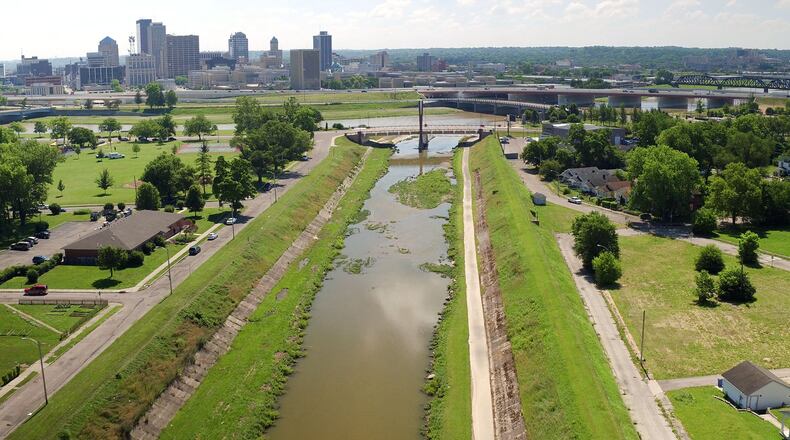To help pay for system maintenance and capital improvements, tens of thousands of properties along the riverfront in five local counties could be charged higher assessments starting next year.
Twenty-two communities and five counties also would be asked to pay more for flood protection.
This would be the first “adjustment” to flood benefits and assessments in a dozen years, said MaryLynn Lodor, general manager of the Miami Conservancy District.
Credit: Nick Graham
Credit: Nick Graham
A property worth $100,000 that is protected by a levee could pay $58 or $292 per year, an increase of $12 or $62, depending on the so-called level of protection.
The proposed maintenance assessment likely would increase to 2.78% from 2.19%. A capital assessment, that was 0.54% until it expired in 2022, likely would be about 1% or lower.
Some large commercial properties and properties owned by major institutions currently pay thousands of dollars in assessments every year.
Flood protection
Miami Conservancy District says the regional flood protection system protects about 1 million people and 47,000 properties across Montgomery, Miami, Butler, Warren and Hamilton counties.
The system protects properties worth a combined $10 billion, including about $2.8 billion in Dayton alone.
The flood protection system includes 55 miles of levees and floodwalls; five dry dams; 185 floodgates; 1,100 acres of floodplain; and 35,000 acres of land to store water.
Credit: Nick Graham
Credit: Nick Graham
The district, which was formed after the Great Dayton Flood in 1913, is funded by individual assessments on properties and “unit assessments” paid by five counties and 22 communities, Lodor said.
More than 42,000 individual parcels contribute to maintenance assessments.
Nearly nine in 10 individual assessments are less than $340 per year, according to a preliminary analysis by the Miami Conservancy District.
The property assessments have not been adjusted since 2012. By law, adjustments cannot happen more frequently than every six years.
Revenues from the assessments have been flat, Lodor said, and the district has collected about $4.3 million annually since 2012.
The district anticipates the system’s maintenance needs will be about $11.5 million annually between 2025 to 2032.
The district has identified $140 million in capital needs for projects like fixing broken levee pipes and repairing cracks and deterioration to the floodwalls.
“Not all of this needs to get done at one time — in fact, we’re attempting to try to take a phased approach,” Lodor said.
About $80 million in capital needs have been identified for the next 10 years to try to prevent a “catastrophic” failure in the system.
Last March, part of the lower upstream concrete wall fell off of the Germantown dam during a high-water event. High-water weather events have been increasing, the district says, and that exposes the system to erosion and additional stress.
Since the flood protection system was finished in 1922, it has stored water to prevent flooding about 2,140 times, Lodor said.
Current assessments are based on 2012 property values, and property values have risen considerably since then. Also, new development has happened along the riverfront and in protected areas since 2012. But those properties are still paying assessments for values from 12 years ago.
Property values and the level of protection are two of the main factors that determine how much property owners pay.
Earlier this month, the Miami Conservancy District Board of Directors approved the creation of a new capital assessment. The last one expired in 2022.
If approved by a body called the Conservancy Court, the new capital assessment would provide spending authority up to $34.5 million to pay to rehab dams, concrete, levees and channels.
Maintenance and capital assessments require Conservancy Court confirmation. The court has nine judges.
The court ordered a readjustment of appraisal benefits in 2020, but that did not happen after Butler County appealed appraisal values to the state that was only resolved several months ago.
Miami Conservancy District also says it will seek grants and low-interest loans to help pay for system improvements and repairs.
Properties protected by levees are considered to receive “full protection.” Properties protected by dams receive “partial protection.”
A $100,000 property in a partial protection area could pay a maintenance assessment of about $29 per year, which would be a $7 increase.
Local municipalities and governments pay unit assessments that are based on the size of the protected areas in their communities.
The city of Dayton currently pays about $865,000 annually for flood protection. Under an updated maintenance assessment, the city could pay about $1.4 million each year.
The city also may need to pay about $500,000 annually for the proposed capital assessment.
“The safeguards and services provided by the Miami Conservancy District are of immeasurable value and are necessary for the Dayton community’s safety and economic vitality,” said Dayton City Manager Shelley Dickstein.
Other organizations in the county that have some of the highest assessment charges include the University of Dayton, Dayton Children’s Hospital, CareSource and some local hotels, commercial properties, schools and office buildings.
Stratacache Tower, located at 40 N. Main St. in downtown Dayton, had an assessment of about $8,700 in 2023. Assessments show up on property tax bills.
Chris Riegel, Stratacache CEO, said, “While no taxpayer loves the idea of increased taxes, the mission of the Miami Conservancy District is critically important, so on balance, such that the money is used wisely, it is likely a good investment for the community.”
University of Dayton officials said the protection of the college’s properties like UD Arena and Curran Place is important and necessary.
“The Miami Conservancy District assessment increase was expected and will be accounted for in our FY2025 budget process,” officials said.
Property owners who disagree with their assessments can file an exception to their appraisal of benefits.
About the Author






